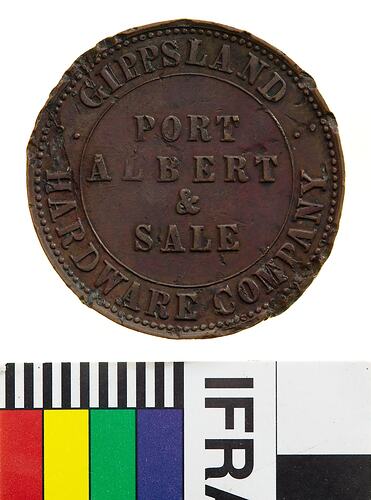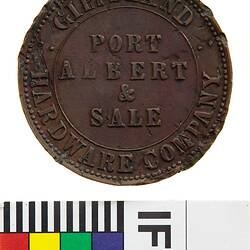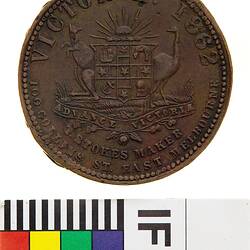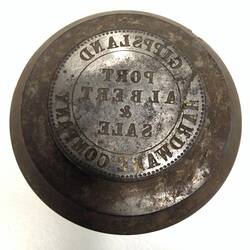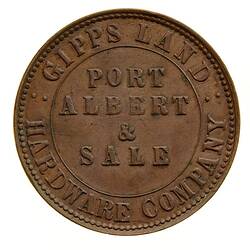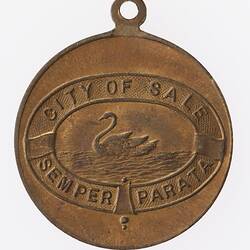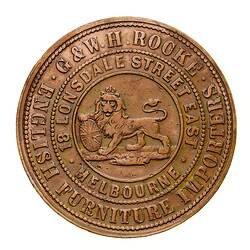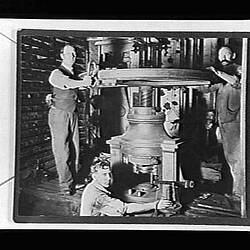Summary
Copper One Penny Token, minted by Thomas Stokes, Melbourne. Issued by Gippsland Hardware Co, Port Albert & Sale, 1862. Gardner asserts that this business was founded in Port Albert in 1859 by James McEwan & Co., Ironmongers, of Melbourne. They sent two Scots, John Thompson and John Neill, to manage the store, replacing Thompson with his brother James after a short time. Both Neill and Thompson returned to Melbourne and the business passed into the management of William Rigg, until it was sold to Nehemiah Guttheridge, a resident of Sale. Guttheridge opened a branch of the store in his own town and took a chemist named Wood as his partner. Gardner believes that it was these two who issued the store's tokens in 1862. As Port Albert declined and Sale grew, the business in the former place was sold off. Mr Guttheridge is said to have been the first Mayor of Sale.
Physical Description
A round copper token (34 mm diameter). The token features the name, address and business of the issuer: Gippsland Hardware Company, Port Albert & Sale. The reverse features a Stokes stock reverse: Coat of arms consisting of a central shield set on grass covered ground and below Rising Sun. On left a kangaroo seated facing out but head back towards sun and on right emu with similar stance. Below ground line and set on bouquet of rose, thistles and shamrock, a ribbon with the motto ADVANCE VICTORIA. The shield is quartered by a cross with a star at the centre and at the end of each arm. The cross is not shaded. The quarters contain: top left, a three-masted sailing ship; top right, a golden fleece; bottom left, an anchor; and bottom right, a wheat sheaf. Around above, VICTORIA . 1862 around below in two lines, T. STOKES MAKER / 100 COLLINS ST. EAST MELBOURNE.
Obverse Description
At centre within a line circle in four lines, PORT / ALBERT / & / SALE around, : GIPPSLAND : HARDWARE COMPANY
Reverse Description
Coat of arms consisting of a central shield set on grass covered ground and below Rising Sun. On left a kangaroo seated facing out but head back towards sun and on right emu with similar stance. Below ground line and set on bouquet of rose, thistles and shamrock, a ribbon with the motto ADVANCE VICTORIA. The shield is quartered by a cross with a star at the centre and at the end of each arm. The cross is not shaded. The quarters contain: top left, a three-masted sailing ship; top right, a golden fleece; bottom left, an anchor; and bottom right, a wheat sheaf. Around above, VICTORIA . 1862 around below in two lines, T. STOKES MAKER / 100 COLLINS ST. EAST MELBOURNE. The neck of the emu is poorly engraved with additional line to the left, the T of EAST is below the letters AK of MAKER. The standard references for the die used to make this token are: Andrews 13 = Heyde Arms 5 = Sharples Arms 6.
Edge Description
Plain
More Information
-
Collection Names
-
Collecting Areas
-
Acquisition Information
Transfer from National Gallery of Victoria (NGV), 15 Mar 1976
-
Date Issued
1862 AD
-
Issued By
Gippsland Hardware Company, Port Albert, South Gippsland, Victoria, Australia, 1862
-
Mint
Stokes (Mint), Melbourne, Greater Melbourne, Victoria, Australia, 1862
-
Previous Collection (Possible)
Mr Alfred Chitty
Previously part of Alfred Chitty or Alfred Yelland Collection. Kenyon's audit suggests a second example after Chittty's that is 'damaged'. -
Previous Collection (Possible)
Dr Alfred A.W. Yelland
Previously part of Alfred Chitty or Alfred Yelland Collection. The Yelland manuscript may have a rubbing of his piece. -
Previous Collection
Numismatics Collection, National Gallery of Victoria (NGV), pre 1976
-
Inscriptions
Obverse: GIPPS LAND HARDWARE COMPANY PORT ALBERT & SALE Reverse: VICTORIA 1862 ADVANCE VICTORIA T. STOKES MAKER 100 COLLINS ST. EAST MELBOURNE
-
Denomination
-
Series
-
Material
Copper
-
Axis
12
-
Classification
-
Category
-
Discipline
-
Type of item
-
Dimensions
34 mm (Outside Diameter), 13.456 g (Weight)
-
Shape
Round
-
References
The trade token issue for the Gippsland Hardware Company required two obverse dies and two reverse dies to produce. The dies are distinguished quite simple: Obverse A: GIPPS LAND is two words (2.0 mm seperate the S and L) Obverse B: GIPPSLAND is one word (0.4 mm seperate S and L) Reverse 1: Depicts a plough Reverse 2: Stokes Stock Arms 6 The following combinations were struck in 1862: A/1, A/Arms 6, B/Arms 6 (this token) The obverse die is cracked on all examples of A/1 examined but is not cracked on A/Arms 6 tokens. From the die deterioration the order of token production was A/Arms 6 then A/1 with die axis 12 and finally A/1 with die axis 06. The change of die axis may relate to an attempt to repair or reinforce the breaking die. In the early Twentieth Century re-striking occured with obverse B, one original strike with B/Arms 6 has been examined (NU3752).
[Article] Sharples, John P. 1993. A Catalogue of the Trade Tokens of Victoria 1848 to 1862. Journal of the Numismatic Association of Australia. vol.7: p.1-77., V. 195
[Book] Heyde, Gilbert C. & Skinner, Dion H. 1967. Unofficial Coins of Colonial Australia and New Zealand., No. 27
[Book] Andrews, Arthur. 1921. Australasian Tokens and Coins., No. 147
-
Keywords
